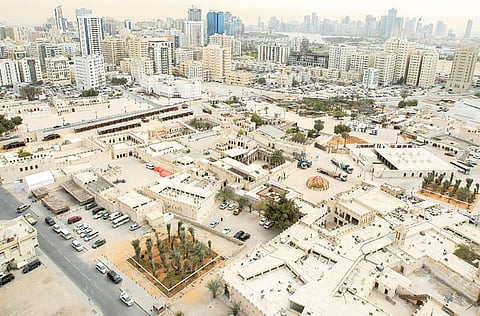‘Heart of Sharjah’ project under way
First phase of largest heritage project in UAE and Gulf region to be completed in 2015

Sharjah: Aiming to retain the feel of the 1950s in Sharjah’s traditional areas, the largest heritage project in the UAE and Gulf region, the ‘Heart of Sharjah’ is currently in progress aiming to create the first development of its kind.
The five-phase, 15-year historical restoration project which aims to restore and revamp the traditional heritage areas of Sharjah, is scheduled for completion in 2025.
The project plans to feature diverse commercial, cultural and residential projects. It also aims to create tourist and trade destinations, including a boutique hotel, restaurants, retail shops, art galleries, traditional and contemporary markets, archaeological sites, museums, play areas, and commercial offices which will be placed in renovated old or ancient houses.
The heritage project is being undertaken by the Sharjah Investment and Development Authority (Shurooq) in cooperation with the Sharjah Department of Public Works and a number of government bodies and departments in the Emirate.
“Executing a project of this scope would be impossible if not for the cooperation of stakeholders across the full spectrum of conservation, heritage, and development,” said Shurooq CEO Marwan Bin Jassim Al Sarkal, who highlighted the Sharjah Department of Culture’s continuous efforts throughout the project.
Phase 1
Starting its renovations in 2010, the project’s first out of five phases is near completion.
As part of phase 1, the foundation works of the Al Hisn Fort, Al Midfa Houses, and Al Tawaweesh House have been checked and evaluated for plans to add an upper floor to the buildings. The design and layout of the buildings is currently under study.
The chipping process has also been completed and the construction team is currently working to repair the façade.
Works were also carried out in October 2012 on Bank Street, the first modern commercial street in Sharjah constructed in the late 1970s. The project was launched after a non-intrusive ground radar survey of the area showed extensive remains of the historic core of the city, including its souq, which lay underneath the tarmac of Bank Street.
Works included a full archaeological excavation, led by Tatsuo Sasaki, Professor Emeritus at the Department of Archaeology, University of Kanazawa, Japan and coordinated between Shurooq, the Sharjah Ruler’s Office, the Directorate of Heritage, and the Directorate of Antiquities.
“It is believed that the town dates back at least to the late 16th century, and the object of the work to be carried out between November 1 and May 2013 will be to identify the foundations from earlier periods in the town’s history in an attempt to accurately date Sharjah’s urban history in this location, as well as to ascertain how it has evolved over the centuries,” said Peter Jackson, Architectural Adviser in the Ruler’s Office.
Situated just five minutes from the city’s Corniche and 10 minutes from Sharjah International Airport, the heritage project which aims to safeguard the emirate’s national historical character aims to complete phase 1 by 2015.
Sign up for the Daily Briefing
Get the latest news and updates straight to your inbox



